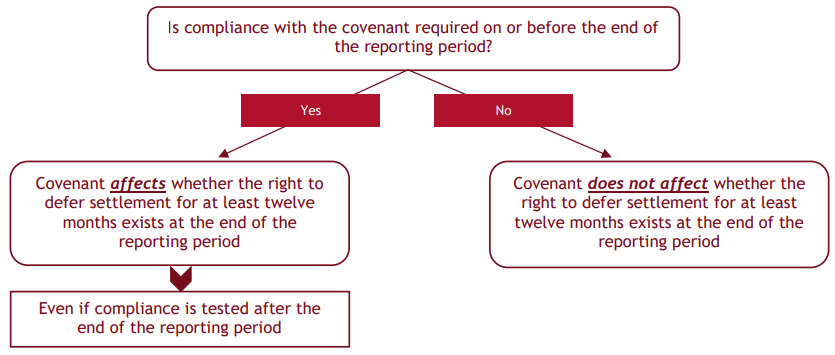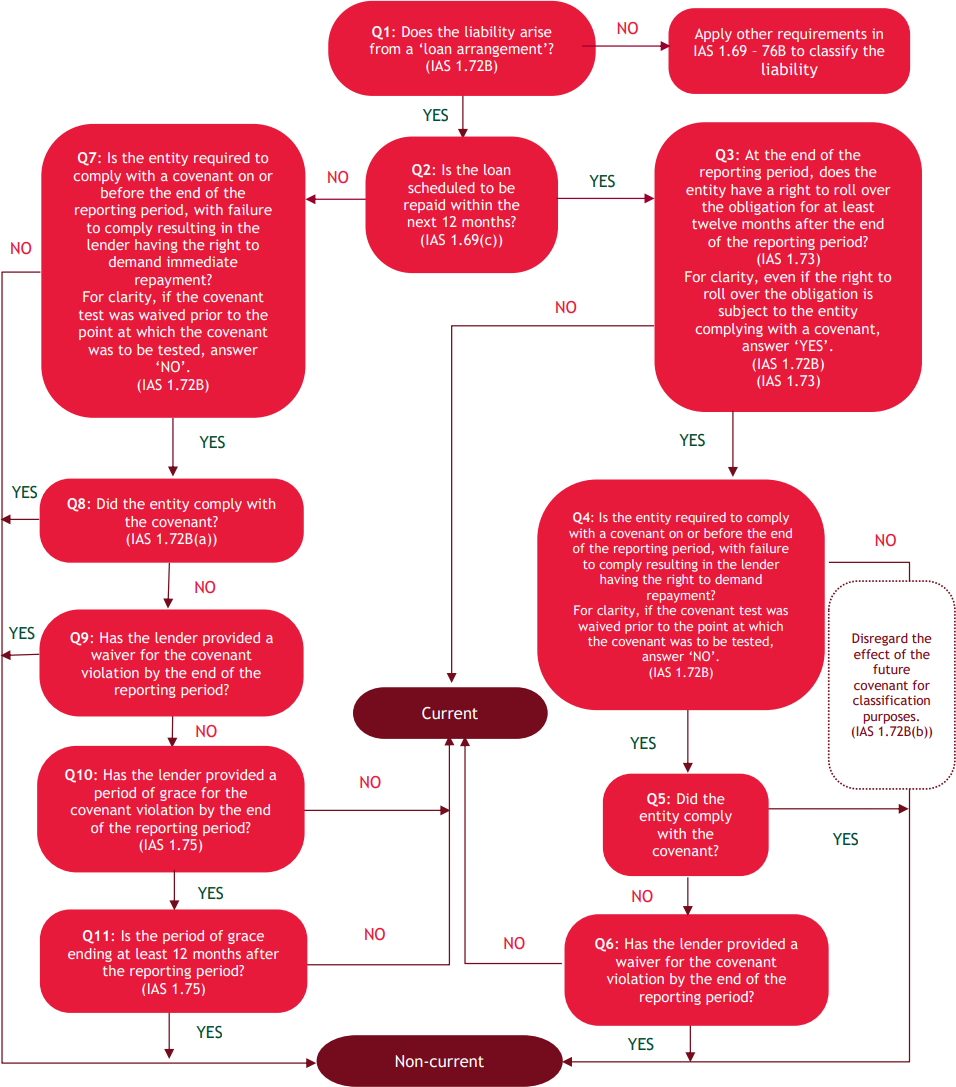Entities may have to reclassify their borrowings at 31 December 2024 – Part 2
Entities may have to reclassify their borrowings at 31 December 2024 – Part 2
New rules for classifying liabilities as current or non-current commence for annual periods beginning on or after 1 January 2024. One of the most complex areas of the new rules relates to entities classifying loan arrangements with loan covenants.
BDO’s recent publication, IFRS Accounting Standards in Practice - Classification of loans as current or non-current, includes a flow chart and numerous examples to help you determine the correct classification of your loan arrangements. Last month, we showcased seven examples of compliance with loan covenants required at the end of or after the reporting period. This article (Part 2) highlights other examples from our publication where compliance with loan covenants is needed before the end of the reporting period and how that impacts the classification of the loan arrangement.
Follow our articles over the next few months to learn how to classify loans where compliance with a covenant is required quarterly, periodically, and more. You can also listen to our webinar for more information about the new classification requirements.
The following diagram summarises whether loan covenants will affect the classification of your loan arrangements (IAS 1 Presentation of Financial Statements, paragraph 72B):

To classify a loan as a non-current liability at the reporting date, it must meet any loan covenant test required on or before the end of the reporting period.
If the entity breaches a loan covenant before the reporting date such that the loan becomes repayable on demand, the loan is classified as a current liability because the borrower does not have a right to defer settlement. However, if the entity obtains, before the end of the reporting period, a waiver for the breach, or a period of grace whereby the borrower agrees not to demand repayment for at least twelve months after the end of the reporting period, the loan is classified as a non-current liability.
Difference between a waiver and a period of grace
Our previous article explains the difference between a waiver and a period of grace in more detail. Neither term is defined in IAS 1, but to put it simply:
|
Period of grace |
Waiver |
|
Lender agrees not to demand immediate repayment of the loan due to the breach for a specified period. |
Lender surrenders its rights related to the breach of covenant |
|
At the end of the ‘period of grace’, the lender regains the right to demand immediate repayment resulting from the breach. |
Permanent waiver – not for a specified period |
|
Suspension of rights. |
Complete surrender of rights. |
Assessing whether there has been a waiver may require a legal interpretation to understand the nature of the rights surrendered or retained by the lender.
Breaches of loan covenants prior to reporting date
Our publication includes a flowchart to help you determine the appropriate classification of a loan arrangement when a covenant has been breached prior to reporting date.
Examples
Our publication illustrates five examples where Entity A must comply with a loan covenant prior to the end of the reporting period (examples B1 to B5) and identifies how this impacts the loan classification at the reporting date. For each example, the publication uses the above flow chart and walks you through step-by-step to arrive at the correct loan classification. For all these examples, the answer to Question 1 (Does the liability arise from a loan arrangement?) is ‘Yes’, and Question 2 (is the loan scheduled to be repaid within the next 12 months?) is ‘No’. Therefore, Questions 7 to 11 need to be considered.
Base fact pattern
Entity A obtains a loan from Bank B on 1 January 20X0. The loan is repayable in full after five years. Given the seasonal nature of Entity A's business, the loan arrangement requires Entity A to have a working capital ratio above 1.1 as of every 31 October. If the covenant test for the working capital ratio is not met, Bank B has the right to demand immediate repayment of the loan. Entity A's annual reporting period ends on 31 December.
Examples B1 to B5
|
|
Example B1 – Anticipated breach is waived on 15 October 20X1 and new debt-equity covenant test for 31 March 20X2 |
Example B2 – Waiver received after the breach on 15 November 20X1 (waiver is before reporting date) |
Example B3 – Waiver received after the breach on 15 November 20X1 and lender demands additional collateral which is provided by 30 November 20X1 |
Example B4 – Breach is waived on 15 November 20X1 and new debt-equity covenant test for 31 March 20X2 |
|
Question 7: Is the entity required to comply with a covenant on or before the end of the reporting period, with failure to comply resulting in the lender having the right to demand immediate repayment? |
No
|
Yes |
Yes |
Yes |
| Note: If the covenant test was waived prior to the point at which the covenant was to be tested, answer ‘NO’. | The covenant test was waived prior to the covenant being tested. | The covenant test was not waived prior to the covenant being tested. | The covenant test was not waived prior to the covenant being tested. | The covenant test was not waived prior to the covenant being tested. |
|
Question 8: Did the entity comply with the covenant? |
N/A |
No |
No |
No |
|
Question 9: Has the lender provided a waiver for the covenant violation by the end of the reporting period? |
N/A |
Yes |
Yes |
Yes |
|
Question 10: Has the lender provided a period of grace for the covenant violation by the end of the reporting period? |
N/A |
N/A |
N/A |
N/A |
|
Classification |
Non-current liability |
Non-current liability |
Non-current liability |
Non-current liability |
From the above examples, we can see:
- It makes no difference whether a waiver is received from the lender prior to a breach or after a breach, so long as the waiver is in place by the end of the reporting period
- When assessing loan classification at 31 December 20X1 (IAS 1, paragraph 72B(b)), they ignore the next annual covenant test on 31 October 20 X2, which occurs only ten months after the reporting date. The same applies to the new covenant tests in examples B1 and B4.
Example B5 – period of grace provided
The facts are similar to example B4 (breach and insertion of a new covenant test after the reporting date), except Entity A receives a period of grace rather than a waiver, the covenant test is based on a current ratio test, and it is performed on 30 November each year rather than 31 October.
Terms of period of grace
Entity A breached the current ratio test on 30 November 20X1. On 15 December 20X1, Bank B agreed it would not exercise its right to demand the loan until on 30 June 20X2. Bank B introduced a new current ratio test for 30 June 20X2 as part of this agreement to not require repayment. After 30 June 20X2, Bank B will reconsider the loan based on the new current ratio covenant. From 1 July 20X2, Bank B has the right to demand repayment of the loan concerning the 30 November 20X1 covenant violation. Bank B has this right irrespective of whether Entity A meets the new covenant on 30 June 20X2.
The loan is classified as a current liability because Bank B did not provide a period of grace of at least twelve months after the end of the reporting period. The flowchart analysis is shown below:
|
|
Example B5 – Period of grace provided by the lender on 15 December 20X1 and current ratio test for 30 June 20X2 |
|
Question 7: Is the entity required to comply with a covenant on or before the end of the reporting period, with failure to comply resulting in the lender having the right to demand immediate repayment? Note: If the covenant test was waived prior to the point at which the covenant was to be tested, answer ‘NO’. |
Yes
The covenant test was not waived prior to the covenant being tested. |
|
Question 8: Did the entity comply with the covenant? |
No |
|
Question 9: Has the lender provided a waiver for the covenant violation by the end of the reporting period? |
No |
|
Question 10: Has the lender provided a period of grace for the covenant violation by the end of the reporting period? |
Yes Bank B has provided a period of grace rather than a waiver because it has not surrendered its rights relating to the breach of covenant. Regardless of the outcome of the new covenant test on 30 June 20X2, Bank B retains the right to demand immediate repayment for the breach that occurred on 30 November 20X1. |
|
Question 11: Is the period of grace ending at least 12 months after the reporting period? |
No |
|
Classification |
Current liability |
Disclosure about standards issued not yet effective
We remind entities preparing Tier 1 general purpose financial statements of the requirement to disclose and quantify the impact of amending standards that will take effect in a later period. Entities with loan arrangements subject to loan covenants will have to assess the implications of these IAS 1 changes on their borrowings and disclose the effect on the comparative and opening balance sheets for reporting periods starting before 1 January 2024.
|
Year-end |
First-time application |
Comparative restatement |
Opening balance sheet |
|
31 December |
31 December 2024 |
31 December 2023 |
1 January 2023 |
|
31 March |
31 March 2025 |
31 March 2024 |
1 April 2023 |
|
30 June |
30 June 2025 |
30 June 2024 |
1 July 2023 |
|
30 September |
30 September 2025 |
30 September 2024 |
1 October 2023 |
More information
For more information on this topic, please look at our new publication or listen to our recent webinar for further explanation and examples.
Need help?
Classifying loan arrangements and other liabilities as current or non-current may be complex. Deciding whether the bank has provided a waiver or a period of grace for a covenant breach can also be tricky, and the hurdle for a waiver is high. Please contact our IFRS & Corporate Reporting team for help.
